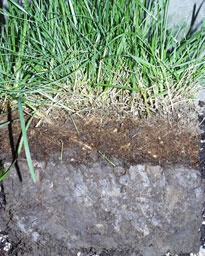
 |
|||||||
 |
Click here for your prompt free quote.
When should I dethatch?Dethaching is the process of removing Thatch from your lawn. As a general rule of thumb, up to 1/2 inch of thatch is O.K.. Remember, thatch can be good for lawns, especially during times of drought, water restrictions, and high heat, when it can act like insulation for the soil by providing a screen from sun light and help to hold in moisture. Conversely, thatch that accumulates in excess of 1/2 Inch can actually work as a disadvantage to your lawn by creating too much buffer between the soil and the grass, thereby preventing sufficient amounts of water, air, and nutrients (fertilizer) to reach the soil. Excess thatch can also encourage the proliferation of pests such a Chinch bugs, insects, and various lawn diseases and fungi. To help determine how much thatch buildup exists in your lawn, simply take a narrow wire or screwdriver and place it in the thatch until it reaches the soil. Then mark how high the thatch reaches up on the wire/screwdriver with your finger. Finally, hold it next to a tape measure or ruler to determine the depth. It's not rocket science, but it will do. If you find that there is an excess of thatch in more than one place in your lawn (usually more the 1/2 inch), then it might be time to dethatch. If you find in excess of 1 inch of thatch in your lawn, then you might seriously consider dethatching soon. Much like aerating, dethatching should be done when your lawn can best recover, usually not during times of drought, water restrictions, and heat waves. For most lawns this is either in the late spring or early fall.
|
|
|